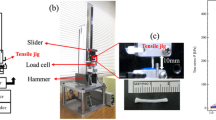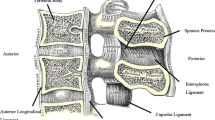Abstract
The response of spinal cord tissue to mechanical loadings is not well understood. In this study, isolated fresh cervical spinal cord samples were obtained from cadavers at autopsy and tested in uniaxial tension at moderate strain rates. Stress relaxation experiments were performed with an applied strain rate and peak strain in the physiological range, similar to those seen in the spinal cord during voluntary motion. The spinal cord samples exhibited a nonlinear stress-strain response with increasing strain increasing the tangent modulus. In addition, significant relaxation was observed over 1 min. A quasilinear viscoelastic model was developed to describe the behavior of the spinal cord tissue and was found to describe the material behavior adequately. The data also were fitted to both hyperelastic and viscoelastic fluid models for comparison with other data in the literature.
Similar content being viewed by others
References
Biot, M. A. Generalized theory of acoustic propagation in porous dissipative media.J. Acoust. Soc. Am. 34:1254–1264, 1962.
Blum, R. H., L. E. Thibault, and T. A. Gennarelli. In-vivo indentation of the cerebral cortex.Proc. 38th ACEMB (Abstract), Chicago, IL, pp. 86, 1985.
Boock, R. J. Vascular Response to Mechanical Deformation. Philadelphia: University of Pennsylvania, Ph.D. Dissertation, 1991.
Chang, G. L., T. K. Hung, and W. W. Feng, An in-vivo measurement and analysis of viscoelastic properties of the spinal cords of cats.J. Biomech Eng. 110:115–22, 1988.
Dehoff, P. H. On the nonlinear viscoelastic behavior of soft biological tissues.J. Biomech. 11:35–40, 1978.
Flugge, W.Viscoelasticity (see 2nd edition). New York: Springer-Verlag, 1975, 194 pp.
Frisen, M., M. Magi, L. Sonnerup, and A. Viidik, Rheological analysis of soft collagenous tissue.J. Biomech. 2:13–20, 1969.
Fung, Y. C.Biomechanics: Mechanical Properties of Living Tissue, New York: Springer-Verlag, 1981 433 pp.
Galbraith, J. A. The Effects of Mechanical Loading on the electrophysiology of the Squid Giant Axon. Philadelphia: University of Pennsylvania. Ph.D. Dissertation, 1988.
Galbraith, J. A., L. E. Thibault, and D. R. Matteson. Mechanical and electrical responses of the squid giant axon to simple elongation.J. Biomech. Eng. 115:13–22, 1993.
Galford, J. E., J. H. McElhaney, A viscoelastic study of scalp, brain, and dura.J. Biomech. 3:211–221, 1970.
Haut, R. C., and R. W. Little. A constitutive equation for collagen fibersJ. Biomech. 5:423–430, 1972.
Hung, T.-K., and G.-L. Chang. Biomechanical and neurological response of the spinal cord of a puppy to uniaxial tension.J. Biomech. Eng. 103:43–47, 1981.
Hung, T.-K., G.-L. Chang, H.-S. Lin, and F. R. Walter. Stress-strain relationship of the spinal cord of anesthetized cats.J. Biomech. 14(4):269–276, 1981.
Margulies, S. S., D. F. Meancy, L. B. Bilston, S. R. Riederer, and N. C. Campeau. In vivo motion of the human cervical spinal cord in extension and flexion.Proceedings of the 1992 IRCOBI Conference, Verona, Italy, pp. 213–224. 1992
Mow, V., G. Ateshian, and R. Spilker. Biomechanics of diarthrodial joints: a review of twenty years of progress.J. Biomech. Eng. 115 (4B):460–467, 1993.
Saatman, K. E., An Isolated, Single Myclinated Nerve Fiber Model for the Biomechanics of Axonal Injury. Philadelphia: University of Pennsylvania, Ph.D. Dissertation, 1993.
Shuck, L. Z., and S. H. Advani, Rheological response of human brain tissue in shear.J. Basic. Eng. 94:905–911, 1972.
Viidik, A. A rheological model for uncalcified parallel-fibred collagenous tissue.J. Biomech. 1:211–221, 1968.
Woo, S. L.-Y., G. A. Johnson, and B. A. Smith. Mathematical modeling of ligaments and tendons.J. Biomech. Eng. 115 (4B):468, 1993.
Author information
Authors and Affiliations
Rights and permissions
About this article
Cite this article
Bilston, L.E., Thibault, L.E. The mechanical properties of the human cervical spinal cordIn Vitro . Ann Biomed Eng 24 (Suppl 1), 67–74 (1995). https://doi.org/10.1007/BF02770996
Received:
Revised:
Accepted:
Issue Date:
DOI: https://doi.org/10.1007/BF02770996




